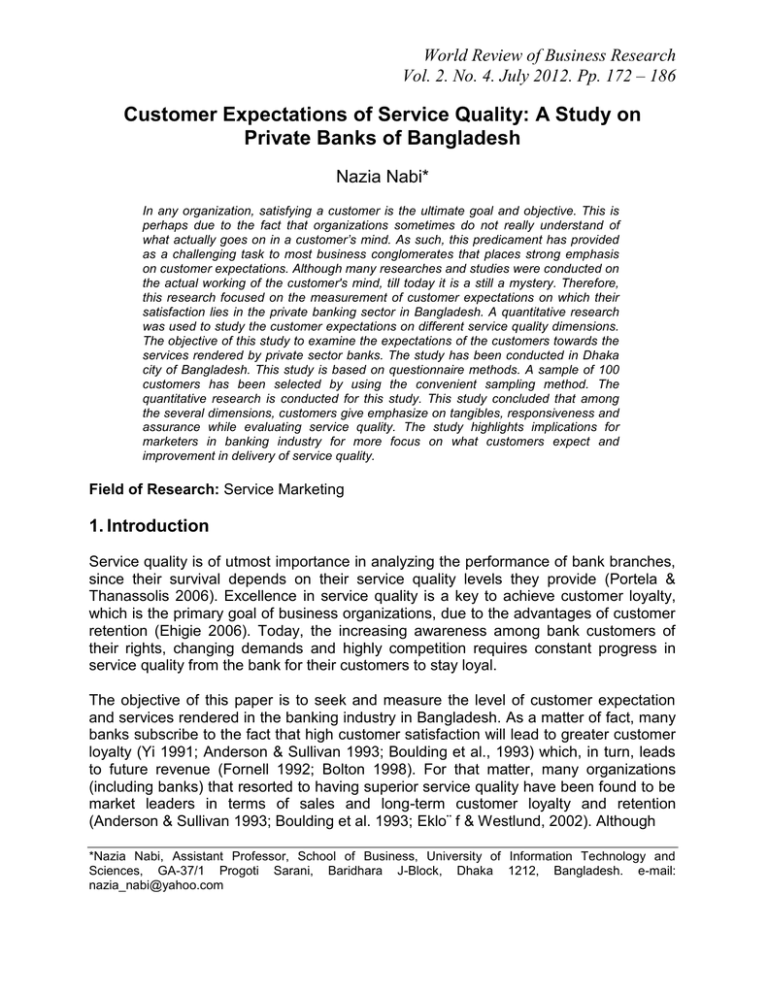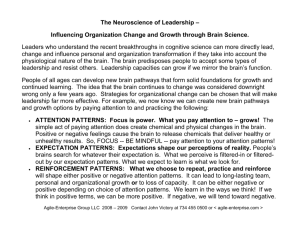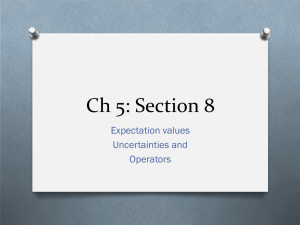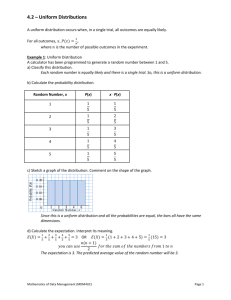Customer Expectations of Service Quality: Private Banks of Bangladesh
advertisement

World Review of Business Research Vol. 2. No. 4. July 2012. Pp. 172 – 186 Customer Expectations of Service Quality: A Study on Private Banks of Bangladesh Nazia Nabi* In any organization, satisfying a customer is the ultimate goal and objective. This is perhaps due to the fact that organizations sometimes do not really understand of what actually goes on in a customer’s mind. As such, this predicament has provided as a challenging task to most business conglomerates that places strong emphasis on customer expectations. Although many researches and studies were conducted on the actual working of the customer's mind, till today it is a still a mystery. Therefore, this research focused on the measurement of customer expectations on which their satisfaction lies in the private banking sector in Bangladesh. A quantitative research was used to study the customer expectations on different service quality dimensions. The objective of this study to examine the expectations of the customers towards the services rendered by private sector banks. The study has been conducted in Dhaka city of Bangladesh. This study is based on questionnaire methods. A sample of 100 customers has been selected by using the convenient sampling method. The quantitative research is conducted for this study. This study concluded that among the several dimensions, customers give emphasize on tangibles, responsiveness and assurance while evaluating service quality. The study highlights implications for marketers in banking industry for more focus on what customers expect and improvement in delivery of service quality. Field of Research: Service Marketing 1. Introduction Service quality is of utmost importance in analyzing the performance of bank branches, since their survival depends on their service quality levels they provide (Portela & Thanassolis 2006). Excellence in service quality is a key to achieve customer loyalty, which is the primary goal of business organizations, due to the advantages of customer retention (Ehigie 2006). Today, the increasing awareness among bank customers of their rights, changing demands and highly competition requires constant progress in service quality from the bank for their customers to stay loyal. The objective of this paper is to seek and measure the level of customer expectation and services rendered in the banking industry in Bangladesh. As a matter of fact, many banks subscribe to the fact that high customer satisfaction will lead to greater customer loyalty (Yi 1991; Anderson & Sullivan 1993; Boulding et al., 1993) which, in turn, leads to future revenue (Fornell 1992; Bolton 1998). For that matter, many organizations (including banks) that resorted to having superior service quality have been found to be market leaders in terms of sales and long-term customer loyalty and retention (Anderson & Sullivan 1993; Boulding et al. 1993; Eklo¨ f & Westlund, 2002). Although *Nazia Nabi, Assistant Professor, School of Business, University of Information Technology and Sciences, GA-37/1 Progoti Sarani, Baridhara J-Block, Dhaka 1212, Bangladesh. e-mail: nazia_nabi@yahoo.com Nabi many researches have been conducted to understand the customer perceptions and loyalty on banking industry, this study focuses, mainly, on the various factors that affect customer expectation. 1.1 Problem Statement This paper provides a brief review of some of the relevant approaches that have been used for the measurement of customer expectation. The problem statements for this research are – a. b. c. To find out the factors that customers evaluate for service quality. To identify the level of customers’ expectation of service quality for a bank. Desired and adequate. To identify the dimension, among the five dimensions of SERVQUALS, that is/are most important for service customers. The problem statement is generated from the consideration that service quality is an important matter to bring more customers, retain the existing ones and create loyalty among customers. Practically, somehow, service provided at a company may not be fully implemented yet and needs some improvements. Also, if a company would evaluate its own service, the understanding from the perspectives of customers is very important. From the perspectives of customers, the assessment of service quality will not be biased. What reflected from the customers’ perspectives could provide a chance for a company to improve its service quality to the right direction. 1.2 Objectives of the Study The study has been conducted to discover the expectations that the customers grip before purchasing or selecting a service or service organization. Our study has been conducted on the private banking sector where the customers form their expectations based on various intangible as well as tangible factors. The objectives of this study are: a. b. c. To know the criterions on which customers select or evaluate a bank’s service. To identify which dimensions of SERVQUALS is/are most important for the customers. And, finally, to assess customers’ possible levels of expectation towards service quality. 1.3 Research Question The research questions for this study are – a. b. c. What are the criterions on which customers select or evaluate a bank’s service? Which dimensions of SERVQUALS is/are most important for the customers? What are the customers’ possible levels of expectation towards service quality? 173 Nabi 1.4 Structure of the Paper The text is divided into seven parts: Part One, ‘Introduction’, introduces to the importance of knowing customer expectation toward service quality; as it is a key tool by which customers evaluate the quality of a bank. Also, the company itself can understand that customers evaluate them based on some criterions and they can develop its service quality at the best possible. Hence, background of the problem were given briefly in this part; followed by Problem Statement, Objective of the Study of this research. Part Two, ‘Literature review’, has been executed in four phases; it discusses, firstly, about the industry; secondly, the meaning of customer expectations; thirdly, the SERVQUALS approach, and lastly, the possible levels of expectations Part Three, ‘Methodology’, explains the research design, questionnaire design and the framework for the factors concerning the research Part Four, ‘Data Analysis and Findings’, discusses the results of the study. As the result of the study calculated by mean and standard deviation calculation, the presenting of data in the findings part is considered easier to understand. Furthermore, the findings are numerical and the tables related to the research are given in Appendix part. Part Five, ‘Conclusion’, concludes the research result. In addition, the research result is concluded with the implication for managers as well as the limitation of the research. Part Six, ‘References’, provide the lists of full bibliographical details and their journal titles. Lastly, Part Seven, ‘Appendix’ is the last chapter of this paper. Here, personal profile of the respondents and the tables used for this reserach are presented. 2. Literature Review 2.1 The Industry In a developing country like Bangladesh the banking system as a whole play a vital role in the progress of economic development. The commercial banking system dominates Bangladesh's financial sector. Bangladesh Bank is the Central Bank of Bangladesh and the chief regulatory authority in the sector. The banking system is composed of four state-owned commercial banks, five specialized development banks, thirty private commercial Banks and nine foreign commercial banks. Together, they represent as the primary mobiliser of funds and as the main source of financing to support the national economic activities. Banking policies, rights and guidelines comes under the purview of the Central Bank of Bangladesh. Guided by the principle that it should act only in the economic interest of the nation, this Bank should not profit as a primary consideration. Based on that, the functions of Central Bank of Bangladesh are carried out within the 174 Nabi context of promoting economic growth, plus a high level of employment, maintaining price stability and finally, a reasonable balance in the country's international payments position, eradicating poverty and restructuring society. In particular, the Central Bank of Bangladesh ensures that the availability and cost of money and credit in the economy are consonant with national macroeconomic objectives. In this respect, the Bank acts as the banker for currency issue, keeper of international reserves and safeguarding the value of the taka, banker and financial adviser to the Government, agency responsible for monetary policy and management of the financial system and banker to the banks. However, there remains a deep concern on what kind of pull that these banks can impact upon their customers in order to entice and retain their customers. Moving from a product and sales philosophy to a marketing philosophy gives the bank a better chance to beat the competition. 2.2 Customer Expectations According to Zeithaml, Bitner, and Gremler (2006), customer expectations are “beliefs about a service delivery that serve as standard against which performance is done”. Davidow and Uttal (1989) proposed that customer expectation is formed by many uncontrollable factors, which include previous experience with other companies, and their advertising, customers’ psychological condition at the time of service delivery, customer background and values and the images of the purchased product. In addition, Zeithaml et al. (1990) stated that customer service expectation is built on complex considerations, including their own pre-purchase beliefs and other people’s opinions. Similarly, Miller also stated that customers’ expectation related to different levels of satisfaction. It may be based on previous product experiences, learning from advertisements and word-of-mouth communication. Santos added that expectation could be seen as a pre-consumption attitude before the next purchase; it may involve experience. Customers’ expectation is what the customers wish to receive from the services. The diversity of expectation definitions can be concluded that expectation is uncontrollable factors which including past experience, advertising, customers’ perception at the time of purchase, background, attitude and product’s image. Furthermore, the influences of customers’ expectation are pre-purchase beliefs, word of mouth communications, individual needs, customers’ experiences, and other personal attitudes. Different customers have different expectation based on the customers’ knowledge of a product or service. 2.3 The SERVQUAL Approach Among general instruments, the most popular model used for evaluation of service quality is SERVQUAL, a well-known scale developed by Parasuraman et al. (1985, 1988). The attributes of (Parasuraman et al. 1985), were: tangibles, reliability, responsiveness, competency, courtesy, assurance, credibility, security, access, and understanding. Parasuraman et al. (1988) later reduced these ten dimensions into five by using a factor analysis. Based on Parasuraman et al. (1988) conceptualization of 175 Nabi service quality, the original SERVQUAL instrument included 22 items. The data on the 22 attributes were grouped into five dimensions: a. b. c. d. e. Tangibles: Well maintained waiting cues, clear and easy bank statement and advice slip, convenient location, Faster operation with modern technology Reliability: Provide services when promised, Responsiveness: Employees attention in solving problems, Employees full service, Promptly Errors correction, Assurance: Safe feeling for transaction, Competitive loan rates, Interest Rate on saving and time deposit, Helpful Employees Empathy: Employees’ search for solutions Although there has been criticism from some other researchers to SERVQUAL instrument (Johnston 1995), yet SERVQUAL is the instrument most utilized for its confirmatory factor analyses in most cases. Thus, up to date, SERVQUAL has proven to be a parsimonious model that has been used in various service organizations and industries to measure service quality including banks (Mc Alexander et al. 1994; Cowling & Newman 1996; Levesque & Mc Dougall 1996; Caruana et al. 2000; Caruana 2002; Sureshchandar et al. 2002; Paswan et al. 2004; Seth et al. 2005; Lymperopoulos et al. 2006). 2.4 Possible Levels of Expectation Customers hold different types of expectations about service, the reference points against which service delivery is compared. The highest can be termed “desired service”: the “wished for” level of performance. The ideal expectation or desire shown in figure 1 is termed desired service because the expectation reflects the hopes and wishes of the customers. The lower can be termed “adequate service”: the level of service customer will accept, that is, their minimum tolerable expectations. As shown in Figure 1, different possible types of service expectations can be arrayed from low to high of this continuum. On the left of the continuum are different types or levels of expectations, ranging from high (top) to low (bottom). Adequate service represents the “Minimum tolerable expectations” where the desired service represents the other four services. 176 Nabi Figure 1: Possible levels of customer expectations Ideal expectation or desires HIGH Normative “should” expectations Experience-based norms Acceptable expectations Minimum tolerable expectations LOW 3. Methodology 3.1 Research Design The methodology employed in obtaining information about customer satisfaction in banking via a survey conducted at a sample of the general consumer population. The survey questionnaire is design and distributed to target respondent randomly. Targeted respondents are the general public who are at the legal age to hold a Savings and/or Current Account in any of the private banks in Dhaka, Bangladesh. Thus, the survey questionnaires are designed to apply to a heterogeneous population, where targeted respondents come from the general open public (from difference genders, age groups, marital status, education backgrounds, designations and professionalisms). Owing to the fact that different levels of the society have different expectations and needs, therefore, the idea of choosing respondents from different backgrounds will most certainly generate a more reliable outcome towards Service Quality by banks. While some responded promptly to the survey, others took a little bit time to digest the questions and enquiries. Nonetheless, overall, most of them are very helpful and kind to 177 Nabi fill our questionnaire patiently and some even provided their own personal opinions. The survey questionnaires were conducted via face-to-face interviews. 3.2 Questionnaire Design For an easy understanding and reading, the questionnaire is designed into three parts. The first part of the questionnaire is taking consideration in the demographic factor of the respondents. The questions are designed with multiple-choice selections for convenience. The second part of the questionnaire is required the respondents of 10 banks to rate the expectation level for the bank they have chosen or attached with into a five pre-defined level scale – starting from “Least important” to ” More important”. The final part of the questionnaire is chosen for any other recommendations the customers want to provide. The aim is to collect the opinions of the respondents in respond to the importance of SERVQUAL in chosen a bank. The answer of the questionnaire is solely based on the respondents` experience and personal opinion. All data collected are fed into the Statistical Package for the Social Sciences (SPSS) for analysis. It is imperative that all information collated is strictly for this research purpose only. Likewise, all information and the identity of the respondent are strictly confidential and will not to be disclosed to any party in any manner. 3.3 Framework of the Factors As mentioned that survey focuses on the finding the customers’ expectation on various services provided by banks, various factors which contribute to the customers’ expectation are taken for this study. These factors came from different studies and include the followings: a. b. c. d. e. f. g. h. i. j. k. l. m. n. Provide services when promised Employees’ attention in solving problems Employees’ full service Promptly Errors correction Helpful Employees Employees’ search for solutions Safe feeling for transaction Convenient service hour Well-maintained waiting cues Clear and easy bank statement and advice slip Faster operation with modern technology Competitive loan rates Interest Rate on saving and time deposit Convenient location 4. Data Analysis and Findings This paper has taken a few important demographic information those indeed influence the customers regarding the selection or evaluation of the banking organization. Among those gender, occupation, income and age are of most important for this study. Most of 178 Nabi the customers were in the age category of 30-39 (32.7%) and male in the gender category (75.5%). 38.8% respondents earned a monthly income between TK. 2500050000. However, the highest number of respondents involved with business, that is, 40.8%. 4.1 The Criterions on Which Customers Select or Evaluate a Bank’s Service To identify the attributes/services of bank, which the customers normally consider while selecting or evaluating the service of a bank, 14 attributes has been selected which are shown in table 1. The importance of various attributes has been ranked by measuring the mean and standard deviation. The analysis of the means and the standard deviation of these variables are depicted in the table 1. In the survey, 57.1 percent of the respondents (which are shown in table 2) have answered the convenient location as very important attribute for selecting a bank and the mean also complies with this by giving the highest value of 4.5510. Subsequently, the other attributes that are of most important for respondents are employees’ full service (53.1% of the sample), promptly error correction (51.0% of the sample), and safe feelings for transaction (46.9% of the sample) and their means are consequently 4.3265, 4.2857 and 4.1425 which comply with the results. Also, the competitive loan rate has the fourth position based on the mean 4.2449, 59.2% respondents of the sample said that the competitive loan rate is quite important, and 32.7% respondents feel that this attribute is very important when they decide to select a bank for loan. 179 Nabi Table 1: Attributes/services considered when selecting/evaluating a bank Minimu Maxim m um Mean Std. Deviation Ranking Provide services 98 when promised 2.00 5.00 4.0612 .87126 7 Employees show serious interest in 98 solving problems 2.00 5.00 4.1224 .89977 6 Promptly correction 98 2.00 5.00 4.2857 .83728 3 98 2.00 5.00 4.3265 .84677 2 Helpful Employees 98 2.00 5.00 3.7143 .67350 9 98 2.00 5.00 3.6531 .77462 10 98 2.00 5.00 4.1429 .97389 5 98 2.00 5.00 3.6122 .83274 11 98 2.00 5.00 3.5714 .97389 12 98 2.00 5.00 4.0612 .82257 7 98 2.00 5.00 3.4694 .86399 13 98 3.00 5.00 4.2449 .59311 4 98 3.00 5.00 3.9388 .68589 8 98 3.00 5.00 4.5510 .53962 1 N Employees service Errors full Employees always search for solutions Safe feeling for transaction Convenient service hour Well maintained waiting cues Clear and easy bank statement and advice slip Faster operation with modern technology Competitive loan rates Interest Rate on saving and time deposit Convenient location On the other hand, the least important attributes for the respondents are shown in table 3 where 12.2% and 10.2% respondents agree that well-maintained waiting cues as well as the faster operation with modern technology are not important to evaluate an organization’s services and the means of these two attributes also show this result with the value of 3.5714 and 3.4694 consequently having the position 12 and 13. 180 Nabi Table 2: Percentage of respondents who answered “very important” for the following attributes Promptly errors correction Employees full service Safe feelings for transaction Convenient location Frequenc y 50 52 46 56 Percent 51.0 53.1 46.9 57.1 Valid Percent 51.0 53.1 46.9 57.1 Cumulative Percent 100.0 100.0 100.0 100.0 Table 3: Percentage of respondents who answered “less important” for the following attributes Frequenc y 12 Well maintained waiting cues Faster operation with modern 10 technology Percent 12.2 Valid Percent 12.2 Cumulative Percent 12.2 10.2 10.2 10.2 4.2 Possible Levels of Expectations The final part of this study is to identify the desired service expectations as well as the adequate service expectations of customers, that is, what they desire from and what they deem acceptable for the service organization. For this purpose, we have taken comments from our respondents from which we have identified five possible types of service expectations. These expectations are shown in figure 2 as a continuum that are ranging from high (top) to low (bottom). For purposes of our study, we focus on those two types. The “desired service”: the “wished for” level of performance. The ideal expectation or desire shown in figure 2 is termed desired service because the expectation reflects the hopes and wishes of the customers. As customers were informed regarding the better service of the bank, they expect the best for their own. The lower can be termed “adequate service”: the level of service customer will accept. As the customers select the bank for location or for the absence of options, they are likely to accept whatever the bank provides, that is, their minimum tolerable expectations. 181 Nabi Figure 2: Levels or types of customer expectations HIGH Ideal expectation or desires The customers of this bank are really delighted with the services, and I want a bank with which I will feel comfortable to transact. Normative “should” expectations As they promised in their promotions and by customer service department, it should have excellent service. Experience-based norms Most of the times this bank is very good in providing services, but when it gets busy in different occasions, the service is slow. I expect the bank to serve me in an adequate manner. Acceptable expectations Minimum tolerable expectations LOW I do not expect good service from this bank, but come because of the convenient location. 4.3 The SERVQUAL Approach From the above table and discussion, it is concluded that customers’ expectations depends mainly on the Tangibles, Responsiveness and Assurance, among the five SERVQUALS instruments and their subcategories used for this study, as customers indicated these attributes as “more important”. Tangibles: Tangibles encompass the appearance of the company representatives, facilities, materials, and equipment, which provide physical representations or images of the service that customers, particularly new customers, will use to evaluate quality. This study shows that tangibles highly influence the customers as these tangibles form the expectation of the customers that what the service quality will be. Among the tangibles 182 Nabi being studied, the highest mean, 4.5510, is for convenient location, as customers prefer the bank with which they will conduct their activities, in a convenient location, although well maintained waiting cues and Faster operation with modern technology got the lowest mean, 3.5714 and 3.4694, as these are less important for customers. As customers expect convenient location rather than any other service dimensions, so it has been proved that tangibles have a significant effect on customer expectation. Responsiveness: Responsiveness is the timely reaction towards the customers' needs. Customers expect Employees full service, which has the second highest mean, 4.3265. It indicates that customers expect the willing ness of employees to help them. Again, promptly error correction has the third highest mean, 4.2857, where customers expect promptness in dealing with their problems. Assurance: Assurance is particularly important for customers as they feel high risk and uncertain about the service. So, Safe feeling for transaction has got the fourth highest mean, 4.1429. 5. Conclusion No business can exist without customers. In the philosophical words of Peppers and Rogers “The only value your company will ever create is the value that comes from customers—the ones you have now and the ones you will have in the future.” This is absolutely true. Customer value is an asset to the organization. Hence, in order to maintain the customer, the organization needs to ensure that the right products and services, supported by the right promotion and making it available at the right time for the customers. While quality service and merchandise are essential in today’s competitive market, it is equally important that a customer experiences the "Wow Effect" that only superior customer service can deliver. A business that caters to their customers` needs will inevitably gain the loyalty of their customers, thus resulting in repeat business as well as potential referrals. Consequently, it is imperative that businesses get to know their customers and their expectations. Establishing a professional relationship with customers empowers a company with the knowledge of what customers need. The feedbacks from the survey are a testament to the customer expectation definitely that some attributes are much more important for the customers to judge a company. Similarly, the other attributes, such as; assurances, tangibles and responsiveness, are of critical importance for the service customers. Of course, one of the difficulties in understanding the true customer requirements is that the customer can and will change them without notice or excuse. As a Marketing Manager in the banking industry, it is pertinent that all the components in a service quality program be strictly followed and implemented effectively. Assurance, reliability, tangibles, customer expectation and customer satisfaction are all equally important. Marketing managers should not only focus on the bank’s objective of profits and gains, but must also look into the needs of the customers as well. Market perception and customer expectation can change rapidly from time to time; perhaps there will be a new trend in the near future. 183 Nabi 5.1 Limitations of the Research This paper attempts to illustrate the attributes that customers expect to evaluate or select a bank for their service. The current study however has some limitations. This study did not take into consideration the samples from different or separate geographical locations. So, people from other locations of Bangladesh may have a different expectation towards customer services offered by banks, owing to the different culture, level of education and some other demographic factors. Although this research is primarily based on the primary data from the users and non-users of the bank, the findings cannot be generalized. This study has successfully examined the major factors expected by the consumers and which are based on respondents’ perception on various applications; future research may include examining the factors importance more deeply. Future research may also consider the impact of demographic variables on customer expectations. References Caruana, A, Money, AH & Berthon, PR 2000, “Service quality and satisfaction- the moderating role of value”, European Journal of Marketing, 34(11/12), pp. 13381352. Caruana, A 2002, “Service loyalty. The effects of service quality and the mediating role of customer satisfaction”, European Journal of Marketing, 36(7/8), pp. 811-828. Cowling, A & Newman, K 1996, “Service quality in retail bankng: the experience of two British clearing banks”, International Journal of Bank Marketing, 14(6), pp. 3-11. Davidow, WH & Uttal, B 1989, “Service Companies: Focus or Falter”, Harvard Business Review, July-August, pp. 77-85. Ehigie, BO 2006, “Correlates of customer loyalty to their bank: a case study in Nigeria”, International Journal of Bank Marketing, 24(7), pp. 494-508. Johnston, R 1995, “The determinants of service quality: satisfiers and dissatisfiers”, International Journal of Service Industry Management, 6(5), pp. 53-71. Levesque, TJ & McDougall, GHG 1993, “Managing customer satisfaction: the nature of service problems and customer exit, voice and loyalty”, Asia Pacific Journal of Quality Management, 2(2), pp. 40-58. Lymperopoulos, C, Chaniotakis, IE & Soureli, M 2006, “The importance of service quality in bank selection for mortgage loans”, Managing Service Quality, 16(4), pp. 365-379. McAlexander, JH, Kaldenberg, DO & Koenig, HF 1994, “Service quality measurement”, Marketing Health Services, 14(3), pp. 34-40. Parasuraman, A, Zeithaml, VA & Berry, LL 1985, “A conceptual model of service quality and its implications for future research” Journal of Marketing, 49, Fall. Parasuraman, A, Zeithaml, VA & Berry, LL 1988, “SERVQUAL: a multiple-item scale for measuring consumer perceptions of service quality”, Journal of Retailing, 64(1), Spring. Paswan, AK, Spears, N, Hasty, R & Ganesh, G 2004, “Search quality in the financial services industry: a contingency perspective”, Journal of Services Marketing, 18(5), pp. 324-338. 184 Nabi Portela, MCAS & Thanassoulis, E 2005, “Profitability of a sample of Portuguese bank branches and its decomposition into technical and allocative components”, European Journal of Operational Research, 162(3), pp. 850-866. Seth, NS, Deshmukh, SG & Vrat, P 2005, “Service quality models: a review”, International Journal of Quality & Reliability Management, 22(9), pp. 913-949. Sureshchandar, GS, Rajendran, C & Anantharaman, RN 2002, “Determinants of customer-perceived service quality: a confirmatory factor analysis approach”, Journal of Services Marketing, 16(1), pp. 9-34. Teas, RK 1993, “Expectations, Performance Evaluation and Consumers’ Perceptions of Quality”, Journal of Marketing, 57, pp. 18-34. Zeithaml VA, Parasuraman A, & Berry LL 1990, “Delivering quality service: Balancing customer perceptions and expectations”, The Free Press, New York, NY. Zeithaml, V, Bitner, M & Gremler, D 2006 “Service Marketing: Integrating Customer Focus across the Firm”, McGraw-Hill, New York. 185 Nabi Appendix Personal profile of the respondents (N=98) Profile Sex Age Income Occupation Male Female 20-29 30-39 40-49 50 or above Below 25000 25000-50000 50001-75000 75001-100000 100000 or more Service Business Housewife Others Frequen cy 74 24 24 32 28 14 26 38 12 14 8 Percent 75.5 24.5 24.5 32.7 28.6 14.3 26.5 38.8 12.2 14.3 8.2 Valid Percent 75.5 24.5 24.5 32.7 28.6 14.3 26.5 38.8 12.2 14.3 8.2 Cumulative Percentage 75.5 100.0 24.5 57.1 85.7 100.0 26.5 65.3 77.6 91.8 100.0 38 38.8 38.8 38.8 40 8 12 40.8 8.2 12.2 40.8 8.2 12.2 79.6 87.8 100.0 186




